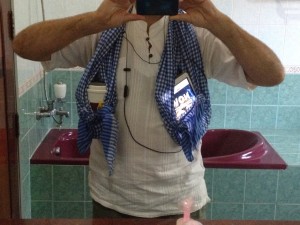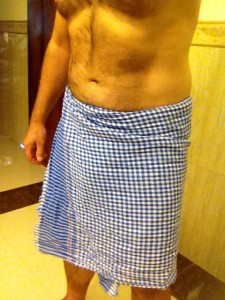The humble Krama is a simple piece of material for which the ingenious Khmer have found a myriad uses.
Tom wrote and presented this short talk about the Krama in class. We investigated some of its timeless solutions to everyday needs, as well as exploring some new uses for the 21st century.
The Krama is a bit of cloth. Not at all exciting – just like every other bit of cotton in the world. Sure, it’s got a lovely chequered pattern in either red or blue, but that’s really just decoration.
It’s only good features are:
You can use it as a sling to carry your baby – or carry your pigs/chickens/ducks to market.
You can wear it as a belt, apron or sarong / man-skirt – or keep the baking Cambodian sun off your head.
You can twist it and wrap it around your head to carry heavy loads, or use it as a hammock to soothe a crying baby.
It can be folded into a shopping bag, or act as a pillow case or bed cover.
On cold mornings a tuk tuk ride feels very chilly – but not if you hang your Krama up as a windbreak, or wrap it around your neck as a scarf.
But like I said… it’s just a piece of cloth.
But in many ways this piece of cloth has been the binding of the Kingdom of Wonder for more than thirty years, since the devasting Khmer Rouge ravaged its social fabric and ripped it apart.
The bustling city of Phnom Penh that I have been living in for the past six months is absolutely filled with smiles.
No trace of Pol Pot’s horrific regime scars its face, though below the surface is another story.
This recovery has been, in some small part, due to the humble, unassuming Cambodian Krama: its people’s bandage, protector, and national symbol.
- www.insightguides.com
- 101usesforakrama.tumblr.com
- thinkprogress.org/climate/2009/02/17/203698 – Socratic irony, Greek theatre, Mark Antony & Abe Lincoln
- en.wiktionary.org/wiki/hypobole A rhetorical figure in which several things are mentioned that seem to make against the argument, or in favour of the opposing side, and then they are refuted one by one.
- http://en.wiktionary.org/wiki/straw_man An insubstantial concept, idea, endeavor or argument, particularly one deliberately set up to be weakly supported, so that it can be easily knocked down; especially to impugn the strength of any related thing or idea.
A double-length Krama hammock.







